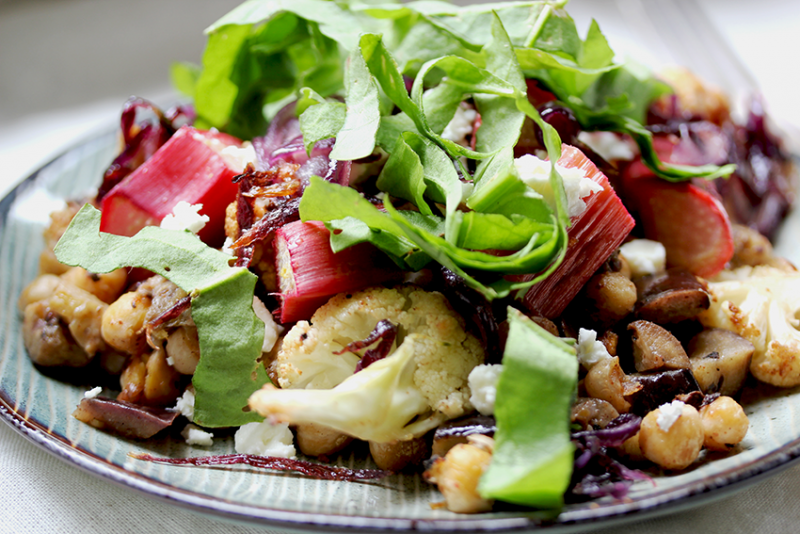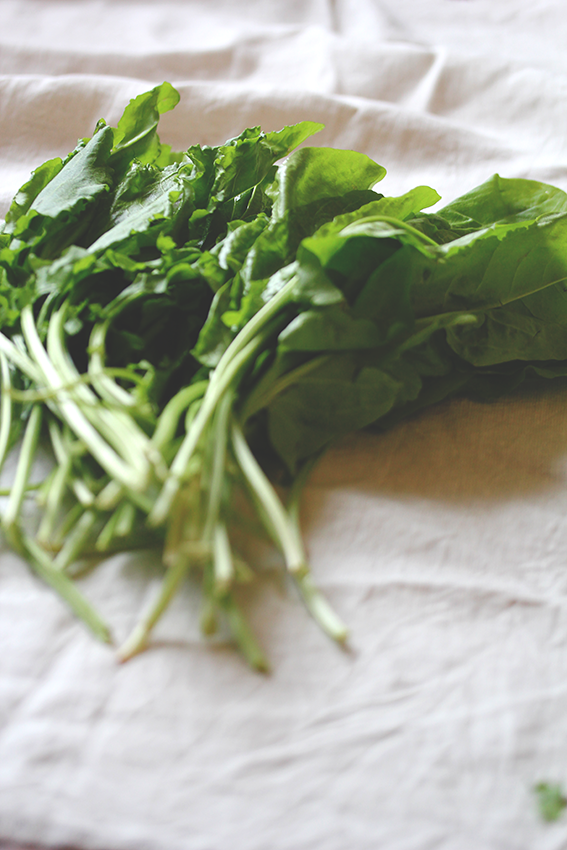Today’s dish is all about sorrel. I am using many leafy greens in my cooking, but the sorrel’s sourness truly makes it something special and gives it the ability to upgrade basically everything. It is by far my most favoured green smoothie ingredient – try half and half together with spinach, some mint, ginger, lime, a bit of avocado, a kiwi or a few berries – delicious! Sadly you can’t find it in the supermarket and only rarely on the market. So I can call myself really lucky to have found my personal supplier – there is a market stall on ‘my’ market that is selling nothing but green leaves grown in their own garden and I am buying a fair share of their weekly sorrel crop. That said, the best way to get hold of this vibrant ingredient is of course to grow it yourself. So if you have a garden or a balcony give it a go!
Key of this little salad is the balance of the warm-earthy flavour of the chickpeas, the aubergine and the cauliflower and the tartness of the sorrel and the rhubarb held together by the sweet note of the onion and the salty feta. Roasted cauliflower is a quite frequent mid-week dinner of mine – I find it incredibly soothing. Usually I am using rather a lot more spices, such a turmeric, chili and coriander seeds. In this case however we do not want to overpower the other flavours.
I also thought it’s time for a general note on the preparation of legumes and grains, since I will be using them quite a lot. First of all, I think you should always buy them dry and not precooked in a can – it is way cheaper, you are in control of the preparation and it is not really so much more time consuming if you cook them in bulk, freeze a part of them or make hummus of leftovers.
Alright, but why is it so important to either soak or sprout legumes and grains? Well, first of all it reduces the cooking time and we all want to save some energy, don’t we? But most importantly, the soaking/sprouting process helps to break down the phytic acid that is present in the outer layer of all grains and legumes and is their natural protection against predators (us). Phytic acid hinders the absorbtion of vital minerals such as calcium, magnesium and zinc – which can in the long run lead to serious deficiencies! Read this article for further information. Soaking will also help to neutralize so called enzyme inhibitors present in all seeds, which prevent the seed from sprouting in a dry state, but cause distress in the gastric tract and reduce protein digestion. This is also why unfermented soy products are highly problematic! Additionally legumes contain two complex sugars (farrinose and stachyose) that are hard to digest. Soaking/ sprouting will help to break these down as well. So the best way to prepare legumes and grains is to soak them for about 24 hours in slightly warm acidic water. The break down process is aided best by the addition of lactobacilli that are present in cultured dairy products such as whey, kefir or yoghurt. If you have a dairy intolerance, add a dash of lemon juice or apple cider vinegar to the soaking liquid. I always use homemade kefir and at first did not quite believe, that the effect would be to be felt immediately, but trust me: this preparation will really ease digestion. An invaluable source for the knowledge about proper food preparation is Sally Fallon’s Nourishing Traditions – which is hereby highly recommended.
But now to the recipe:
200g cooked chickpeas (chickpeas will have to be cooked for about 50-60 minutes)
1 small Aubergine
1/2 cauliflower
3 rhubarb stalks
ca. 100g sorrel
1 red onion
a few springs of dill
80g feta (optional)
3 tbsp coconut oil
1 tsp freshly grounded cumin, allspice and nutmeg
1tsp sumach
75ml rosé wine
1-2 tsp rice malt syrup
1 tsp almond butter
sea salt and black pepper to taste
Preheat the oven to 200°C. Divide the cauliflower in florets of the same size. Dice the aubergine (but not to thinly otherwise it will be ready much earlier than the cauliflower). In an ovenproof dish mix with the freshly ground spices, a generous pinch of sea salt and 1 tbsp melted coconut oil. Roast the vegetables for about 30 minutes – the should have become tender, yet still be a little ‘al dente’.
Chop the rhubarb in ca. 3cm pieces; in another ovenproof dish, whisk together rosé, syrup and a little salt and allspice. Toss the rhubarb in the mixture, making sure it is all covered with some liquid. Place for about 10 minutes in the oven – make sure it does not fall apart but retains its shape. Keep the liquid for the dressing!
Slice the onion quite thinly. Let it slowly caramelize in a saucepan with a thick bottom in 1 tbsp coconut oil until it’s very soft and nicely browned. This will take 15-20 minutes. In another pan fry the chickpeas in some coconut oil, to the end adding sea salt and sumach. Meanwhile chop the sorrel, dill and feta (if using).
In a bowl carefully mix chickpeas, the roasted vegetables, the rhubarb and the onion. To make the dressing whisk together the rosé liquid and the almond butter and season to taste with sea salt and allspice or black pepper. Mix with the ingredients and top with the feta, sorrel and dill.


